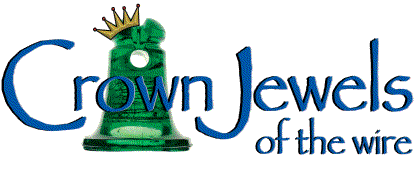Letters to the Editor
Reprinted from "INSULATORS - Crown Jewels of the Wire", November 1974, page 30
Dear Dora:
I think that I have told you that I was working on a book which will concern
non-glass and non-porcelain insulators. There will be a section on hook
insulators, and I read with interest the reprint of the old book, "The
Telegraph in America", which mentions the Leffert block insulator. The text
therein speaks of a line being constructed very quickly after the formation of
the company, New York and New England telegraph Company, early in 1849. The text
also speaks of the use of the Leffert.
This would date the Leffert block, which is a hook insulator (rams horn), as
being used at least as early as 1850. And so the Leffert block is a real oldie.
The first patent for a line insulator was granted in 1851 to Batchelder.
The picture of the Leffert block in the reprint is quite different from the
one in Frank Jones' reprint of "Modern Practise of The Electric
Telegraph", which book was printed originally in 1874.
I am very interested in the hooks. I have recorded over thirty patents issued
on them, and I am sure many collectors will be interested in that category in my
new book. Publishing date not yet set.
Gerald Brown
Dear Dora,
I read Jack Tod's column in the September issue. I also read a very
interesting letter from Bernard Warren of Anchorage concerning misspelling on
some Imperial insulators. In that letter Mr. Warren stated that these Imperials
could have come only from him or Ken Marsh. I would like to state that they
could have come from me, as I have sold 40 or 50 of them myself. The majority of
these white porcelains have the porcelain misspelled as "ian" or
"inn". At least 60% of the two hundred I have seen that came from the
Klondike area were misspelled; so I think a correct spelling is more of a
rarity.
In fact, I may bring out that I'm the original discoverer of the white
Imperial that came from the Klondike area, and Dora Harned has the first one
ever found there, which I gave her. I might also add that all the
"LIMAS" that came off the same line, I have, to my knowledge, the only
one with a double stamp. One side has LIMA stamped into it, and the other side
has LIMA written in script on it. I have also discovered that some of these
white Imperials have the crown on them with no date, and one with a date of
3-4-99 on it. In my own collection I have two with such a tough glaze that they
look like they are covered with small pimples and craters.
Sincerely,
Gordon Marsh
P.S. Thought of the month: Never show an outsider your hunting grounds, or
you may be the outsider!!!
Dear Dora:
In the book "The Glass Insulator, A Comprehensive Reference" by
Cranfill and Kareofelas, they have listed a F - McLaughlin B - NO 16, CD-122
style, but having a round wire groove.
It has four differences from its CD-122 counterpart, but only two of them
would be considered CD variations. First, it does have a round wire groove, but
it also measures 2-7/8" across the base, while the: regular CD-122 is only
2-3/4" across the base.
I know that it may seem that every time someone has an insulator with a
difference, he wants a new CD number assigned. What do you think about this one?
Good Collecting,
Jerry Gibby, NIA #388
| 